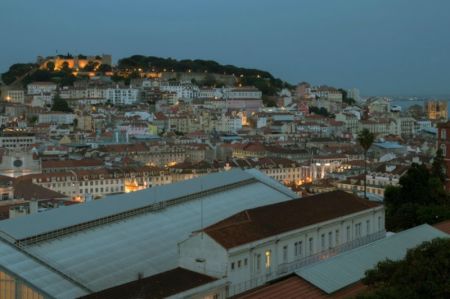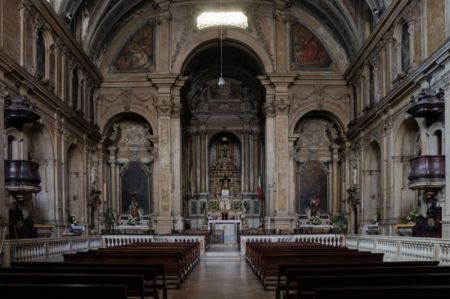Spires and Crosses: Jetsetting to Portugal in Search of Lisbon's Historic Churches
Lisbon isn't a place that one thinks of first when planning a trip across the pond.
Yet, the Portuguese capital (population 506,892) should be atop your list of where to go, right now.

Best discovered in the fall, winter or spring — July and August can be brutally hot — the city's Old World charm includes several notable churches and a cathedral that dates to the Moorish occupation of the Iberian Peninsula.
While tourism has exploded in recent years partly due to
Portugal's inexpensive cost of living and the improved marketing of its excellent food and wine, the number of fanny pack-wearing Americans is still relatively small compared to Paris or London.
What to do
The Patriarchal Cathedral of St. Mary Major is where everyone goes, which means you should arrive early in the morning to avoid the tour buses and hawkers.

The Sé, as it is more commonly called, is the seat of the Roman Catholic archbishop of Lisbon.
It may not have the grandeur of Europe's more famous cathedrals, but a careful study of its architecture reveals a blend of styles from 12th century Romanesque and 13th century Gothic to the baroque, neoclassical and rococo styles that were fashionable after an earthquake in 1755 destroyed most of the city.
There are a half-dozen other notable Catholic churches, but unfortunately most have little or no information in English and many are seemingly closed to visitors. I couldn't even find an official map or guide to Lisbon's historic churches, including at the gift shop in the Sé.
Among the churches that are open are the Church of the Italians (Igreja do Loreto), which was established in 1518 only to be rebuilt first after a fire in 1651 and then again after the 1755 earthquake, and the Church of Our Lady of the Incarnation (Igreja da Nossa Senhora da Encarnação).
Both churches are situated across from each other, a visible reminder of the gate in the city's 14th century walls that visitors to Lisbon once passed through. Today the area is better known for Camões Square (Praça Luís de Camões), which divides the popular Chiado and Bairro Alto neighborhoods.

The Church of the Italians, named after the Venetian and Genoese merchants that once lived in Lisbon, seems to be ignored by tourists and locals alike, at least that was the case when I visited. I was taking a picture of its north porch when a little old lady with a mop in one hand waved at me. She didn't speak English and I didn't speak Portuguese, but it was clear she knew I would appreciate the chance to come inside.
The interior, illuminated only by light from the clerestory windows, was striking, not least because of the 12 side chapels constructed from expensive Italian marble. Unable to communicate with the cleaning lady and with no obvious guidebook for visitors, I left after a few minutes.
The scene across the street at the Church of Our Lady of the Incarnation couldn't have been more different. This church was clearly on the tourist trail, as there was a constant flow of tourists snapping pictures and locals taking a seat in the pews to say a prayer.
Beyond its baroque and rococo architecture, Our Lady of the Incarnation has ornate paintings on both the ceiling of its nave and the walls and ceilings of a hallway from the south side of the nave that led to the sacristy.
By far, St. George's Church was my favorite in Lisbon — and not because I'm Anglican and this is a Church of England congregation. As they say, it's all about location.
Hidden away in the middle of the British Cemetery, itself a destination to discover names long ago forgotten, St. George's is a world removed from the hustle and bustle of a capital city.

The quaint Romanesque revival-style church with its pink exterior is a notable departure from the Gothic revival architecture that was prevalent in the 1880s, when it was built to replace an earlier English church.
Sadly, one cannot access St. George's unless the cemetery gate on Rua São Jorge is open. Worse yet, visiting hours (10:30 a.m. to 1 p.m., Monday-Friday) are limited and even then the gate isn't always open during published visiting times. To guarantee access, you may want to time your visit before Sunday church services.
Where to stay
I can't say enough good things about Hotel da Estrela, a former school-turned-boutique hotel. With only 19 rooms and suites, it is part of the aptly named Small Luxury Hotels of the World.
Located about 20 minutes by foot from Lisbon's historic center, the hotel is a shorter walk from the British Cemetery and the Jardim da Estrela (Star Gardens), a late 19th century park with great people watching.
In the warmer months, be sure to also book an afternoon picnic. Rooms begin at 72 euros (about $85).
How to get there
The best way to visit Portugal is on TAP, the national airline. The airline, which has partnerships with both JetBlue and United, offers a competitively priced business-class product that allows one to cross the Atlantic in style without breaking the bank.

I flew on TAP's A330 aircraft and found the service to be good, the food and drinks exceptional and the extra amenities — the on-board espresso machine and an amenity kit (eye mask, lotion, toothbrush and toothpaste, etc.) inspired by the design of a sardines can — not only thoughtful, but superior to anything offered on U.S. airlines.
TAP just needs to improve its on-the-ground experience, which reminded me more of a low-cost carrier. In particular, the lounges for business-class passengers, both at its home base in Lisbon and at New York's J.F.K. Airport, were underwhelming.
I wouldn't hesitate to fly TAP again. After all, I can think of no better way to visit a country than to fly its national airline. Plus, the airline allows free stopovers if you want to continue onward to other European destinations. Round-trip airfares from New York City in business-class are consistently about $3,400 through the summer of 2018, according to a search on Google Flights.
Getting around in Lisbon is cheap and super easy through ride-sharing service Uber, though I walked pretty much everywhere. The city is really the perfect size to explore on foot.
Spires and Crosses is published every Sunday.






















